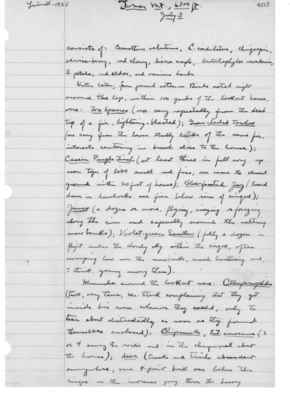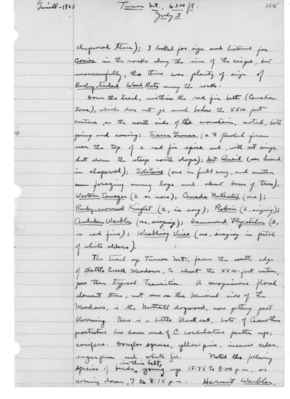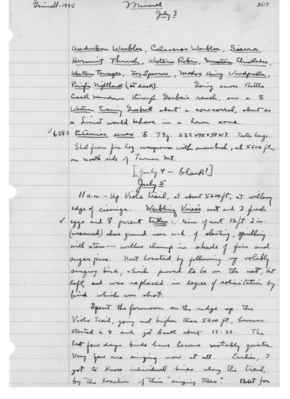Pages That Mention Turner Mountain
1925: Joseph Grinnell's field notes
S2 Page 63
Collector: Grinnell - 1925 Location: Mineral, 4800 ft. Date: July 2 Page Number: 2516
we came. The four young are saved in formalin: 6282 Hammond Flycatcher, 4 small young under this number.
Other birds seen on the big meadow this forenoon were: Vaux Swift (3 flew close over the tree-tops); Tree Swallow (twittering young in company of adults were flying about over the open part of the meadow); Western Bluebird (a family on fence and in meadow).
July 3 5 p.m. - With the family on Turner Mountain, the highest elevation immediately south of Battle Creek Meadows - altitude "6300 feet", according to Mr. J.M. Stark, in winter a school-teacher in Corning, for the three summer months Forest Service Lookout on this Mountain. From here, we get a grand view (after a thunderstorm - 43 lightning strikes counted by Mr. Stark - earlier this afternoon) of Brokeoff Mt. and Mt. Lassen, and the vast surrounding timbered mountain mass. On the north side of this mountain is a perfect glacial cirque (a residual snow bank under its rim now) with a series of hummocky moraines, and two lakes impounded. A few scrub red firs and two or three alpine hemlocks and mountain pines straggle around the uppermost rim; below, around the lakes, are close stands of hemlock and lodgepole pines, the timber elsewhere above about the 5500 contour being red-fir. But the greater portion of the area in the vicinity of the top, is covered densely with chaparral. Right here on top this chaparral is wind-beaten but dense, and
S2 Page 64
Collector: Grinnell - 1925 Location: Turner Mt., 6300 ft. Date: July 3 Page Number: 2517
consist of: Ceanothus velutinus, C. cordulatus, chinquapin, service-berry, red cherry, Sierra maple, Arctostaphylos nevadensis, A. patula, red alder, and various herbs.
Written later, from pencil notes. - Birds noted right around the top, within 100 yards of the lookout house, were: Fox Sparrow (one sang repeatedly from the dead tip of a fir, lightning-blasted); Green-tailed Towhee (one sang from the lower stubby limbs of the same fir, interests centering in the brush close to the house); Cassin Purple Finch (at least three in full song up near tops of live small red firs, one came to cleared ground within 20 feet of house); Blue-fronted Jay (heard down in the hemlocks and firs below rim of cirque); Junco (a dozen or more, flying, singing or foraging along the rim and especially around the melting snow banks); Violet-green Swallow (fully a dozen in flight under the cloudy sky within the cirque, often swooping low over the snowbanks, much twittering and, I think, young among them.
Mammals around the lookout were: Callospermophilus (two, very tame, Mr. Stark complaining that they got inside his room whenever they could, only to tear about distractedly as soon a they found themselves enclosed), Chipmunks, Eut. amoenus (3 or 4 among the rocks and in the chaparral about the house); deer (tracks and tails abundant everywhere, one 4-point buck seen below the cirque on the moraines going thru [sic] the heavy
S2 Page 65
Collector: Grinnell - 1925 Location: Turner Mt., 6300 ft. Date: July 3 Page Number: 2518
chaparral there); I looked for sign and listened for Conies in the rocks along the rim of the cirque, but unsuccessfully, tho there was plenty of sign of Bushy-Tailed Wood Rats among the rocks.
Down the trail, within the red fir belt (Canadian Zone), which does not go much below the 5500 foot contour, on the north side of the mountain, noted, both going and coming: Sierra Grouse (a [male symbol] flushed from near the top of a red fir spire and, with set wings, shot down the steep north slope); Mt. Quail (one heard in chaparral); Solitaire (one in full song, and another seen foraging among logs and about bases of trees); Western Tanager (2 or more); Canada Nuthatch (one); Ruby-crowned Kinglet (2, in song); Robin (2, singing); Audubon Warbler (one, singing); Hammond Flycatcher (2, in red firs); Warbling Vireo (one, singing in patch of white alders).
The trail up Turner Mt. from the south edge of Battle Creek Meadows, to about the 5500-foot contour, goes thru [sic] typical transition. A conspicuous floral element there, not seen on the Mineral side of the Meadows, is the Nuttall dogwood, now getting past blooming. There is a little black oak, lots of Ceanothus prostratus low down and of C. cordulatus farther up; conifers: Douglas spruce, yellow pine, incense cedar, sugar pine, and white fir. Noted the following species of birds ^in this belt, going up 12:45 to 3:00 p.m., or coming down, 7 to 8:15 p.m.: Hermit Warbler,
S2 Page 66
Collector: Grinnell - 1925 Location: Mineral Date: July 3 Page Number: 2519
Audubon Warbler, Calaveras Warbler, Sierra Hermit Thrush, Western Robin, Mountain Chickadee, Western Tanager, Fox Sparrow, Modoc Hairy Woodpecker, Pacific Nighthawk (at dusk). Going across Battle Creek Meadows through Gerber's (?) ranch, saw a [male symbol] Western Evening Grosbeak about a cow-corral, about as a Linnet would behave in a lower zone.
6283 Eutamias senex [male symbol] 79g. 232x98x34x17. Testes large. Shot from fir log overgrown with snowbush, at 5500 ft., on north side of Turner Mt.
July 4 - blank!]
July 5 11 a.m. - Up Viola trail, at about 5600 ft., at willowy edge of cienaga. Warbling Vireo's nest and 3 fresh eggs and female parent taken: rim of nest 12 ft. 2 in. (measured) above ground near end of slanting, spindling will [sic] stem - willow clump in shade of firs and sugar pine. Nest located by following up volubly singing bird, which proved to be on the nest, but left, and was replaced in degree of solicitation by bird which was shot.
Spent the forenoon on the ridge up the Viola Trail, going not higher than 5600 ft., however. Started a [sic] 8 and got back about 12:30. The last few days birds have become notably quieter. Very few are singing now at all. Earlier, I got to know individual birds along the trail, by the location of their "singing trees." But for



